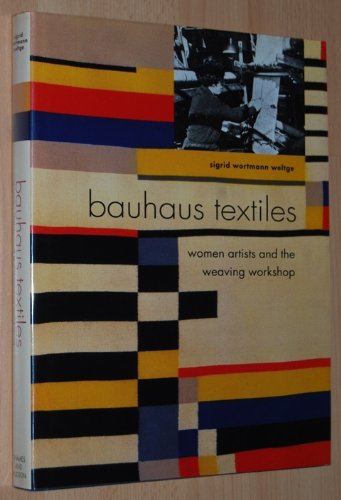Verwandte Artikel zu Bauhaus textiles: Women Artists and the Weaving Workshop

Inhaltsangabe
The place of the Bauhaus in the history of 20th-century design is unchallengeable. Yet the Weaving Workshop, the longest standing and most successful of all Bauhaus workshops, has been neglected. Why? For one simple reason - its artists were almost all female. When these brilliantly talented women arrived at the school, they soon found that Gropius could not sustain his ringing declaration of equality "between the beautiful and the strong gender". Textiles were to be "women's work". The consequences - both in the early days of artistic expression in Weimar and in later developments for industry - could hardly have been foreseen. The Bauhaus weavers produced fabrics which incorporated new or unusual materials, which had acoustic and light-reflecting properties, and which were reversible. They produced multi-layered fabrics, cloths with double and triple weaves, and later made extensive use of the Jacquard loom. In this study, illustrated with rare or little seen illustrations of the works themselves, Sigrid Wortmann Weltge recreates the heady atmosphere of creative excitement at the Bauhaus. Original archival research, and interviews both with survivors and their students and leading contemporary designers, detail the workshop's history and its enduring legacy. When the Nazis closed the institution in 1933, its members dispersed to Switzerland, Holland, England, France, Russia, Mexico and many centres in the United States. This book unearths the missing chapter in the story of the most important institution in the history of modern design, and resurrects the work of gifted craftswomen, for too long denied their due as pioneers in their field.
Die Inhaltsangabe kann sich auf eine andere Ausgabe dieses Titels beziehen.
Reseña del editor
The place of the Bauhaus in the history of 20th-century design is unchallengeable. Yet the Weaving Workshop, the longest standing and most successful of all Bauhaus workshops, has been neglected. Why? For one simple reason - its artists were almost all female. When these brilliantly talented women arrived at the school, they soon found that Gropius could not sustain his ringing declaration of equality "between the beautiful and the strong gender". Textiles were to be "women's work". The consequences - both in the early days of artistic expression in Weimar and in later developments for industry - could hardly have been foreseen. The Bauhaus weavers produced fabrics which incorporated new or unusual materials, which had acoustic and light-reflecting properties, and which were reversible. They produced multi-layered fabrics, cloths with double and triple weaves, and later made extensive use of the Jacquard loom. In this study, illustrated with rare or little seen illustrations of the works themselves, Sigrid Wortmann Weltge recreates the heady atmosphere of creative excitement at the Bauhaus. Original archival research, and interviews both with survivors and their students and leading contemporary designers, detail the workshop's history and its enduring legacy. When the Nazis closed the institution in 1933, its members dispersed to Switzerland, Holland, England, France, Russia, Mexico and many centres in the United States. This book unearths the missing chapter in the story of the most important institution in the history of modern design, and resurrects the work of gifted craftswomen, for too long denied their due as pioneers in their field.
„Über diesen Titel“ kann sich auf eine andere Ausgabe dieses Titels beziehen.
EUR 13,78 für den Versand von Vereinigtes Königreich nach Deutschland
Versandziele, Kosten & DauerSuchergebnisse für Bauhaus textiles: Women Artists and the Weaving Workshop
Bauhaus Textiles : Women Artists and the Weaving Workshop
Anbieter: Marcus Campbell Art Books, London, Vereinigtes Königreich
Hardcover. First Edition. 23 x 29cm 208pp near fine hardback in dust jacket featuring two hundred and twenty illustrations in total, one hundred and twenty-two in colour. Many essays including: 'The Gender Issue' and 'The Question of Identity'. Near fine in near fine dustjacket. Artikel-Nr. 20141
Anzahl: 1 verfügbar
BAUHAUS TEXTILES
Anbieter: Mooney's bookstore, Den Helder, Niederlande
Zustand: Very good. Artikel-Nr. 9780500236581-2-2
Anzahl: 1 verfügbar

